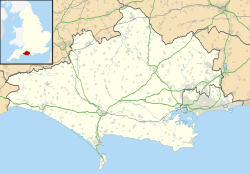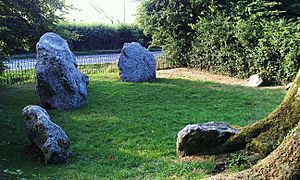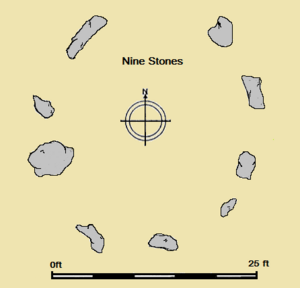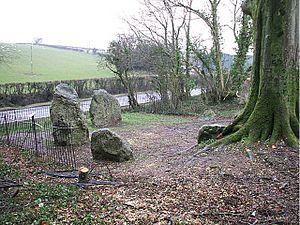Nine Stones, Winterbourne Abbas facts for kids
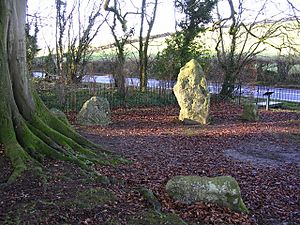
The circle in 2004
|
|
| Location | Winterbourne Abbas |
|---|---|
| Coordinates | 50°42′44″N 2°33′10″W / 50.71217°N 2.55266°W |
| Type | Stone circle |
| History | |
| Periods | Neolithic / Bronze Age |
| Site notes | |
| Ownership | English Heritage |
The Nine Stones is an ancient stone circle located near the village of Winterbourne Abbas in Dorset, England. It is also known by other names like the Devil's Nine Stones or the Nine Ladies. Experts who study old things, called archaeologists, believe it was built a very long time ago during the Bronze Age.
This stone circle is part of a bigger tradition. Many stone circles were built across Great Britain, Ireland, and Brittany between 3300 and 900 BCE. This was during the Late Neolithic and Early Bronze Age periods. People also built circles from wood and large earthen henges. These circular monuments became very important. We don't know exactly why these stone rings were built. Some archaeologists think the stones might have represented special spirits or gods to the people who built them. At least nine stone circles are known in the area around modern Dorset. These circles are usually smaller than others found elsewhere in Great Britain. They are often made from a type of rock called sarsen.
The Nine Stones circle sits in a narrow valley. It measures about 9.1 meters (30 feet) across. It has nine large, irregularly placed sarsen stones. There is a small opening on its northern side. Two stones on the northwest side are much bigger than the others. This special design might have been a deliberate choice by the builders. It could have had a symbolic meaning for them. Similar designs are seen in some stone circles in southwestern Scotland.
People called antiquarians first became interested in the site in the 1700s. Later, archaeologists also studied it, but they have not dug it up. Local folklore stories have grown around the circle. Some link it to the Devil or to children who turned into stone. Local Druids see the Nine Stones as a sacred site. They sometimes hold religious ceremonies there. The circle is next to the A35 road and surrounded by trees. English Heritage owns the site, and visitors can explore it for free.
Contents
Exploring the Nine Stones' Location
The Nine Stones circle is found at a specific spot on the map, called national grid reference 36100904. It's on the western edge of Winterbourne Abbas village in Dorset, South West England. The circle is protected by iron railings. Trees surround it on three sides, and the A35 road is on its northern side. The roots of a large beech tree have grown around two of the huge stones in the circle.
Archaeologist Aubrey Burl once said that this "petite ring" should be lovely to see. However, he found it "frustrating" because of its tight location. He also noted that it was hard to take clear photos because of all the surrounding trees.
Understanding Ancient Stone Circles
Around 3,000 BCE, there was a big change in the types of monuments people built in southern and eastern England. Earlier, people built long burial mounds and large earthworks. But these stopped being built. Instead, people started creating circular monuments. These included earthen henges, wooden circles, and stone circles.
Stone rings are found in most parts of Britain where there is stone. They are most common in southwestern Britain and northeastern Scotland. People built these stone circles for a very long time, possibly for 2,400 years. The main period of building was between 3000 and 1300 BCE.
These ancient stone circles usually show little sign that people visited them often right after they were built. This suggests they weren't used for everyday rituals that would leave many traces. Historian Ronald Hutton thinks they might have been "silent and empty monuments." Archaeologist Mike Parker Pearson suggested that in ancient Britain, stone was linked to the dead, and wood to the living. Other experts think the stones might have represented gods or other powerful beings.
Dorset has a few stone circles, about nine possible ones. Archaeologist John Gale calls them "a small but significant group." All of them are within five miles of the sea. Most are on the chalk hills west of Dorchester. The Dorset circles are simple in design and quite small. None are larger than 28 meters (92 feet) across. They are all oval-shaped, though their original shape might have changed over time. Most are made of sarsen stone. This stone might have come from the Valley of Stones, a place near Littlebredy.
Experts believe the Dorset circles were built during the Bronze Age. They might not all have been built at the same time. It's possible they were used, and even built, into the Middle and Late Bronze Age. These circles are similar to those found on Dartmoor and Exmoor to the west. They also resemble the Stanton Drew stone circles to the north. It's also possible that these stone circles were connected to earthen henges built in Dorset around the same time.
Design and Features of the Nine Stones
The Nine Stones circle is one of the most studied stone circles in Dorset. It measures about 9.1 meters (30 feet) from north to south. The stones are made of sarsen or a rock called conglomerate. There is a gap between two stones near the road. This gap might mean there was once a tenth stone in the circle. Because of its size, only a few people could gather inside the circle at one time.
Seven of the nine stones are less than 90 centimeters (3 feet) tall. But two stones on the northwest side are much larger. One is thin and pointed, reaching 2.1 meters (7 feet) high. The other is wider, measuring 1.8 meters (6 feet) across. The largest stone weighs about 7.3 tonnes (8 tons). It would have taken many people to move and set it upright.
This difference in stone sizes is unique among Dorset's stone circles. It was likely a deliberate choice by the builders. Similar circles exist in southwestern Scotland, like the Loupin' Stones and Ninestane Rig. These also have two taller stones on their edges. This might suggest a connection between Dorset and southwestern Scotland. For example, the Grey Mare and her Colts, an ancient burial mound near the Nine Stones, also shares design similarities with mounds in Scotland.
Where the Circle Sits in the Landscape
The Nine Stones circle is located at the bottom of a narrow valley. This is unusual for this type of monument. However, the Rempstone stone circle in Dorset was also built in a valley.
An old record by John Aubrey mentions another stone circle. It was about a kilometer (half a mile) west of the Nine Stones. It was similar in size but later destroyed. In the 1930s, three stones were still there. Later, John Gale thought this site might not have been a stone circle at all. It could have been the remains of an early burial tomb. Since nothing is left, it's hard to know for sure.
There is also a fallen standing stone called the Broad Stone. It is 2 meters (6.6 feet) long and lies next to the road. This is about 1.5 kilometers (0.9 miles) west of the Nine Stones. In the 1800s, it was recorded as being 3 meters (10 feet) long.
The Nine Stones Through Time
Early Studies and Archaeology
The Nine Stones circle was first written about by John Aubrey in the 1600s. Then, William Stukeley recorded it in the 1700s. Both noted that there were nine large stones at the site. Stukeley's drawing from 1723 shows the monument.
In the 1800s, Charles Warne visited the site. He wrote about it in his 1872 book Ancient Dorset. He claimed he could see a tenth stone. However, when archaeologists Stuart and Cecily Piggott visited in 1936, they found no evidence of this. John Gale later said this claim "has never been substantiated."
In 1888, the local council declared the Nine Stones an "ancient monument." This protected it under the Ancient Monuments Protection Act of 1882. In August 1916, it was officially listed as a scheduled monument. As of 2003, the site had not been dug up by archaeologists.
Local Stories and Beliefs
By 1908, the stone circle was known as the "Nine Ladies" and the "Devil's Nine Stones." In 1941, local stories linked it to the Devil and even to human sacrifice. In 1968, it was still called the "Devil's Nine Stones." One man from Winterborne St Martin said in 1966 that the stones were the Devil, his wife, and his children. Many ancient sites in Britain have names that connect them to the Devil. Folklorist Jeremy Harte believes these names came about later, not during the early Christian period. They often replaced older local legends.
In 1965, a woman from the Isle of Portland said her father always took off his cap when passing the circle. At the same time, a local story said that the stones in the ring could not be counted. This idea of "countless stones" is found at many other ancient sites in Britain. The earliest written record of this idea is from the 1500s, about Stonehenge. Later, it was also said about other stone circles. Folklorist S. P. Menefee suggested this belief might come from an idea that these large stones had their own lives.
In the mid-1970s, archaeologist Leslie Grinsell heard a folk tale. It said the stones were once children who were turned to stone. This was punishment for playing a game on a Sunday. This story, about humans turning to stone for playing on a Sunday, was common for many ancient monuments in southwestern Britain by the 1700s. It is likely linked to religious beliefs about keeping Sunday special.
In 1984, Jeremy Harte spoke to people living nearby. He found that the monument was also called "Lady Williams and her Dog." This referred to a family who lived at Bridehead House. Harte also shared a story from January 23, 1985. A tow truck was pulling a car past the Nine Stones. At 9:15 pm, its engine stopped, and the lights on both vehicles failed. News reports wondered if this event was linked to special energy lines or unidentified flying objects seen near Eggardon Hill.
Images for kids


